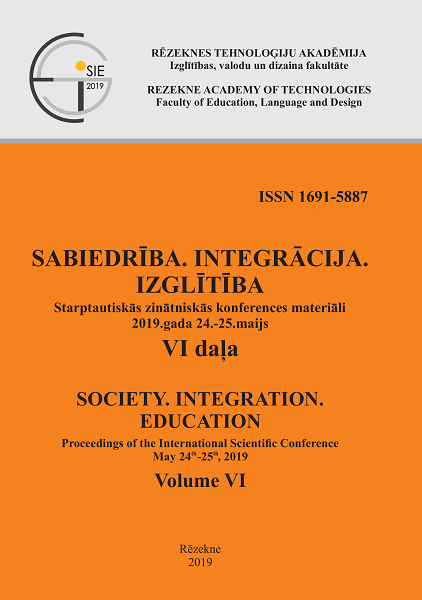REGIONAL COMPETITIVENESS ANALYSIS AND ITS IMPLICATIONS FOR THE SPATIAL PLANNING OF LATGALE REGION
DOI:
https://doi.org/10.17770/sie2019vol6.3710Keywords:
spatial planning, competitiveness of regions, regional developmentAbstract
This paper offers a contribution to contemporary studies of spatial planning. In particular, it focuses on the relationship between competitiveness and spatial planning. In the topical academic debates, there has been a growing interest in raising new paradigms to introduce innovative ways of undertaking long-lasting regional development problems. Territorial assets and spatial qualities have increasingly been regarded as factors for attracting on economic activities and increasing the competitiveness of regions. Spatial and non-spatial policies, planning documents, may have a significant role in enhancing the competitiveness of regions and territories by changing endogenous factors and producing shifts related to positioning and increasing the competitiveness of regions. This paper contains an analysis of competitiveness dimensions in the spatial planning documents of Latgale planning region (Latvia) by focusing on a quantitative analysis of the specific dimensions of competitiveness.
References
Adams, N., Ezmale, S., & Paalzow, A. (2006). Towards Balanced Development in Latvia: The Experience of the Latgale Region. In: Adams, N., & Alden, J., & Harris, N. (Ed.), Regional Development and Spatial Planning in an Enlarged European Union. Aldershot: Ashgate, 199- 220.
Alden, J. (2006). Regional Development and Spatial Planning. In: Adams, N., & Alden, J., & Harris, N. (Ed.), Regional Development and Spatial Planning in an Enlarged European Union. Aldershot: Ashgate, 17 - 42.
Audretsch, D. & Feldman, M. (2004) Knowledge Spillovers and Geography of Innovations. In: Henderson Vernon, J., & Thisse, J. F. (Ed.), Handbook of Regional and Urban Economics. Volume 4, Cities and Geography. Amsterdam: North – Holland, 2713 – 2740.
Begg, I. (1999). Cities and Competitiveness. Urban Studies, 36(5-6), 795–809. DOI: https://doi.org/10.1080/0042098993222
Braun, E. (2008). City marketing: Towards an Integrated Approach. ERIM PhD Series in Research Management. Retrieved from http://repub.eur.nl/res/pub/13694/
Bristow, G. (2011). Territorial Competitiveness and Local and Regional Economic Development: A Classic Tale of‚ theory led by policy. In: Pike, A., & Rodriques - Pose, & A., Tomaney, J. Handbook of Local and Regional Development. London and New York: Routledge, 344 – 355.
EC (2011). An Inventory of Community actions in the field of multilingualism - 2011 update. Retrieved from http://ec.europa.eu/languages/pdf/inventory_en.pdf
EC (2003). A study on the Factors of Regional Competitiveness. A draft final report for EC Directorate – General Regional Policy. Retrieved from https://ec.europa.eu/regional_policy/sources/docgener/studies/pdf/3cr/competitiveness.pdf
Ežmale, S. (2010). Telpiskās plānošanas loma konkurētspējas priekšrocību identificēšanā un izmantošanā sekmīgai Latgales reģiona attīstībai. Latgales Tautsaimniecības pētījumi. Sociālo zinātņu žurnāls, 1(2), 97 – 111.
Ežmale, S. (2011). Latvijas reģionu attīstība un telpiskā plānošana Eiropas Savienības politiku kontekstā. Promocijas darbs. Daugavpils: Daugavpils Universitāte.
Ežmale, S. (2018). Telpiskā plānošana un prakse Latvijā. Society. Integration. Education. Proceedings of the International Scientific Conference. Volume VI, May 25th -26th, 2018, 176-187.
Gordon, I. (2011) .Territorial Competition. In: Pike, A., & Rodriques - Pose, A., & Tomaney, J. (Ed.), Handbook of Local and Regional Development. London and New York: Routledge, 30 – 42.
Kunzmann, K., (2006). The Europeanization of Spatial Planning. In: Adams, N., & Alden, J., & Harris, N. (Ed.), Regional Development and Spatial Planning in an Enlarged European Union. Aldershot: Ashgate, 43 - 64.
Lekwa, V.L., Rice, T.W., & Hibbing, M.V. (2007). The Correlates of Community Attractiveness. Environment and Behavior. 39(2), 198-216. Retrieved from http://faculty.ucmerced.edu/sites/default/files/mhibbing/files/lekwa_rice_and_hibbing_2007.pdf
Metaxas, T. (2002). Place / City Marketing as a Tool for Local Economic Development and City’s Competitiveness: a Comparative Evaluation of Place Marketing Policies in European Cities: 2002, 1 - 42. Retrieved from http://www3.ekf.tuke.sk/re/Marketing%20a%20manazment%20uzemia/city_place_marketing.pdf
Myers, D. (1987). Community - Relevant Measurement of Quality of Life: A Focus on Local Trends. Urban Affairs Quarterly, September. Retrieved from http://www-rcf.usc.edu/~dowell/pdf/community.pdf
Moulaert, F., & Mehmood, A. (2011). Spaces of social innovation. In: Pike, A., & Rodriques - Pose, A., & Tomaney, J. (Ed.), Handbook of Local and Regional Development. London and New York: Routledge, 212 - 225.
Serrano, A. (2003). City Competitiveness and attractiveness: a New Approach to Evaluate Economic Development in Mexican Cities. Doctoral Thesis, Department of Urban Studies, University of Glasgow. Retrieved from http://theses.gla.ac.uk/982/
Servillo, L., Atkinson, R., & Paolo Russo, A. (2011). Territorial attractiveness in EU urban and spatial policy: a critical review and future research agenda. European Urban and Regional Studies, 21 December, 2011. Retrieved from http://eur.sagepub.com/content/early/2011/12/19/0969776411430289
Schwab, K., Porter, M. E. (2006). Global competitiveness report 2006 - 2007. Geneva: World Economic Forum. Retrieved from http://www.euskomedia.org/PDFAnlt/congresos/16/16485491.pdf






